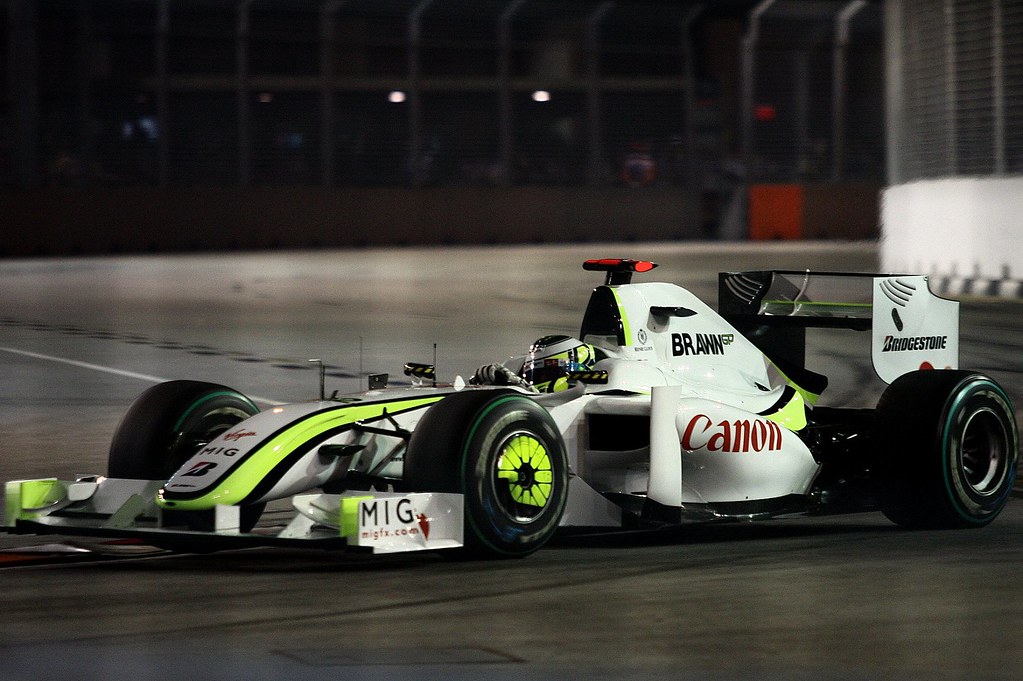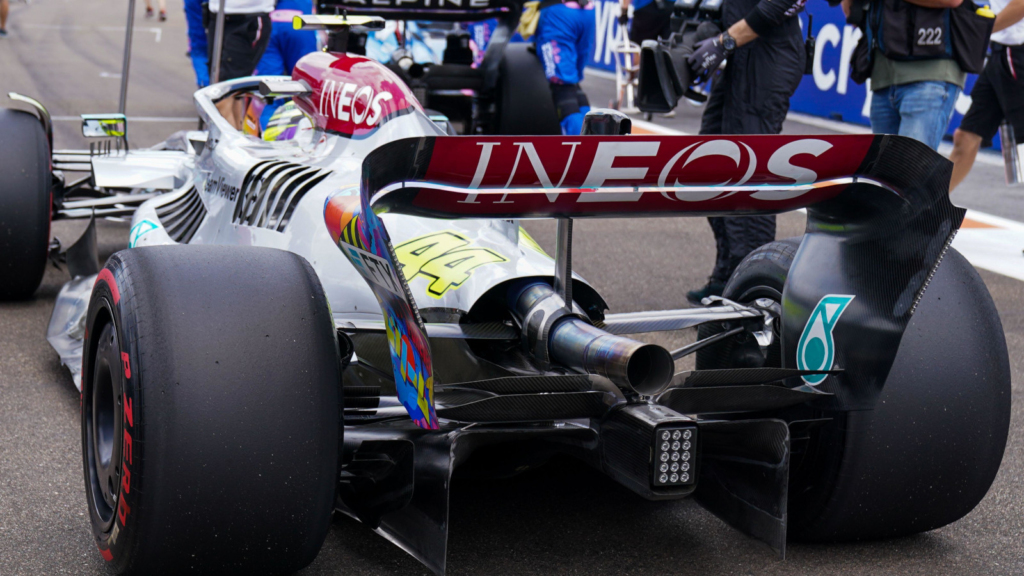What is a Diffuser in Formula 1?
An F1 diffuser is an aerodynamic component located at the rear underside section of a Formula 1 car, right below the rear wing. Shaped like an inverted triangle, its core purpose is to help accelerate the airflow running under the car and utilize that accelerated air to create downforce.
As an F1 car moves forward, air passes underneath the flat bottom of the chassis. This area between the track surface and the car floor is called the ‘venturi tunnel’. As the fast-moving air enters this constricted space, its speed increases while its pressure drops. The diffuser then helps guide this lower pressure air out from underneath the rear of the car.
This accelerated air exiting the diffuser interacts with the slower moving and higher pressure air flowing over and around the rear bodywork. Managing this transition is key to making the diffuser work effectively.
How Does an F1 Diffuser Create Downforce?
As the fast-moving air exits the diffuser, it expands outwards and upwards into the surrounding air. This expansion creates an area of low pressure underneath and behind the car, causing the higher pressure ambient air above to get ‘sucked’ downwards onto the car body from above. This pushing down effect is what creates downforce.
The more efficiently the diffuser can accelerate the underbody airflow and maintain attached flow as it expands out the back, the lower the pressure that can be created, and thus more suction effect to press the car into the track. This improves traction and grip, allowing faster cornering speeds.
Balance Between Downforce and Drag
An effective diffuser creates lots of downforce with relatively low drag. But teams must fine tune the design to find the optimal balance between the two. Too much focus on only downforce can also increase drag on the straights, hampering top speed.
Brawn GP’s Double Diffuser in f1 car for 2009
The 2009 season saw a regulation change that refocused aerodynamic development towards the front wing and away from the diffuser. Most teams adapted their cars accordingly.
However, Brawn GP went an unconventional route. Technical director Ross Brawn together with chief aerodynamicist Loic Bigois seized upon a loophole in the new rules concerning the rear crash structure slot between the rear wheels.
They pioneered the ‘double diffuser’ – essentially splitting the single diffuser into a main upper channel and a smaller lower one. This allowed better expansion of the underbody airflow for increased downforce. The design went unprotested in pre-season and proved immediately dominant, with Jenson Button and Brawn GP winning 6 of the first 7 races.
The double diffuser gave Brawn an advantage of almost 1 second per lap over teams like McLaren and Ferrari early on. Following the concept’s legality being upheld by FIA, other teams eventually incorporated similar designs, but Brawn GP and Jenson Button had already built an insurmountable lead and won both titles that year.

What Made the Double Diffuser So Effective?
The key to the double diffuser’s potency was taking advantage of a rule allowing a hole for the crash structure between the rear wheels. Brawn GP innovated the way this empty space integrated with the diffuser panel.
This enabled better expansion of underbody airflow relative to the single channel diffusers. More air could pass through and energize the crucial vortices along the diffuser sides. This maximized diffuser pressure differential for increased downforce.
The unconventional approach to rules interpreted by others as restricting F1 diffuser development gave Brawn GP a creative advantage. With the car benefiting from Honda’s early focus on the 2009 regulations, the team exploited that head start to great effect with the double diffuser.
The story of Brawn GP is a phenomenon in the world of Formula 1. In 2023, a documentary TV series was made by Keanu Reeves about the success of Brawn GP and how they went to win the Championship as underdogs. The TV series is considered to be one of the 6 best Formula1 movies & series to watch.
Modern Diffuser Design Concepts in F1
Although banned after 2009, the basic principles of the double diffuser continue to inform evolution of the component. Complex curved profiles, precision winglet pairs and 3D contoured shapes define contemporary F1 diffusers.
Blown Diffuser
In 2011 off-throttle exhaust blowing over the diffuser was banned. So engineers innovated to use the on-throttle exhaust gases. Teams like Red Bull pioneered carefully tailoring exhaust position to blow hot gas over the diffuser to energize flow even when the driver lifts off throttle in corners.
This makes the diffuser less sensitive to changes in throttle or ride height variation through corners. But it requires precise gearing between diffuser and exhausts. The engineers also have to be careful to retain rear stability from the effects of these blowing aerodynamics.
Scrolled and 3D Diffusers
More recent designs weave in complex 3-dimensional winglets and vanes into the main diffuser plane. Mercedes has developed a distinctive scrolled profile with curled vertical strakes guiding vortex generation. The rear crash structure slot is also morphed to sculpt channels for air movement between upper and lower diffuser sections.
These represent some of the detailed engineering excellence fundamental to exploiting every hundredth of a second possible within the regulations.
Further Integration
As aerodynamic demands become ever more extreme, no part lives in isolation. The F1 diffuser has become increasingly integrated with surrounding structures – the rear impact structure, gearbox fairings, brake duct flows and floor edges now seamlessly blended into a cohesive whole.
Smooth track-to-diffuser connection helps limit tyre squirt issues also. This aero-mechanical synthesis optimizes expansion and pressure recovery for definitively boosting rear end grip.
The Vital Role of Diffusers in Overall Car Performance
Formula 1 technical regulations may tightly constrain diffuser physical dimensions. But within those limitations lie endless refinements for competitive advantage. We explore some key aspects linking diffusers to overall car performance below.
Downforce and Grip
The primary purpose of a diffuser is generating downforce for traction and cornering speed gains. As it expands airflow outwards, the pressure differential sucks the car towards the track. This effect increases exponentially relative to car speed, advancing grip when its needed most through high speed turns.
Balance and Handling
The diffuser also plays a role managing overall aerodynamic balance between front and rear downforce as well as drag induction. Too much rear bias can make the car unpredictable under braking, while insufficient rear platform compromises acceleration grip. Careful diffuser design helps tune this balance.
Adaptability
Race tracks vary widely in characteristics, making adaptability crucial. Low downforce settings suit power tracks like Monza; high levels are needed at Hungary or Singapore. Engineers actively alter diffuser configuration between races to complement targets for wing level and car rake at individual circuits.
Peak Performance
At the razor’s edge of competition, extracting small percentages quickly multiplies. An excellent diffuser optimizes airflow management across a spectrum from low speed corners to 300 kph straights, coupling with the floor and other aero structures. Together these make up a delicately balanced aerodynamic system enabling the peak performance required to challenge for championships.

Technical Regulations Influencing Diffuser Design
Formula 1 engineers operate within tightly defined regulatory constraints dictating permissible diffuser dimensions and geometry. Nonetheless, relentless creativity constantly challenges boundaries to maximize performance from the rules.
Diffuser Dimension Limitations
Regulations specifically govern various physical parameters of F1 diffusers – maximum height, width, distance from the rear wheel centerline and more. These boundaries limit teams from adopting extreme solutions and provide cost control in development.
Prescriptive Shaping Rules
More detailed geometrical directives are also imposed – mandated curve radii, staircase underside structures and slot gap widths for the rear impact protection spar passing through the diffuser. Teams manipulate small deviations within the wording seeking advantage.
Future Regulation Shifts
Periodic changes to diffuser regulations attempt closing off exploited loopholes and improving safety. This requires teams adapting innovative new concepts within freshly defined bounds – such as 2009’s reframing that sparked Brawn GP’s game-changing double diffuser.
The Forefront of Formula 1
For all Formula 1’s high-tech spectacle and cutting edge technology, a crucial fulcrum point enabling the incredible performance rests beneath – hidden from obvious view except to the most technically literate. Yet this component – the humble F1 diffuser – showcases the pinnacle of design and engineering skill powering the world’s fastest cars.
Understanding the nuances of diffuser functionality provides a portal into the astounding capabilities these complex machines possess. But more profoundly, it represents the human drive to question and create at the extremes; to transcend perceived limits with imagination and science.
This definitively signals Formula 1 as both entertainment and crucible for progress. Because concealed within convoluted carbon nestled under rear crash structures lie ideas that may someday improve everyday reality – born of chasing victory on Sunday to echo through following days.

